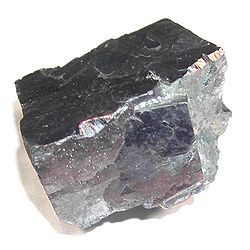Dawsonite
Revision as of 18:14, 6 December 2009 by Physchim62 (talk | contribs)
| Galena | |
|---|---|
 Galena crystal from Galena, Kansas | |
| General | |
| Category | Sulfide minerals |
| Chemical formula | PbS |
| Strunz classification | 05.BB.10 |
| Dana classification | 16a.03.08.01 |
| Crystal symmetry | 2/m 2/m 2/m |
| Identification | |
| Molar mass | 144.00 |
| Color | white |
| Crystal habit | encrustations or radial |
| Crystal system | orthorhombic |
| Cleavage | perfect on {110} |
| Fracture | uneven |
| Mohs scale hardness | 3 |
| Luster | vitreous |
| Streak | white |
| Diaphaneity | transparent |
| Specific gravity | 2.436 |
| Refractive index | nα = 1.466 nβ = 1.542 nγ = 1.596 |
| Birefringence | δ = 0.130 |
| 2V angle | 77º |
| References | [1][2] |
Dawsonite is a mineral composed of sodium aluminium carbonate hydroxide, chemical formula NaAlCO3(OH)2. It was discovered in 1874 during the construction of the Redpath Museum in a feldspathic dike on the campus of McGill University on the Island of Montreal, Canada.[1] It is named after Canadian geologist Sir John William Dawson (1820–99).[2]
The type material is preserved in the collection of the Redpath Museum.
See also
- Dihydroxialumini sodium carbonate, the commercial form, used as an antacid
References
- ↑ 1.0 1.1 Dawsonite, <http://www.mindat.org/show.php?id=1240> (accessed 6 December 2009), MinDat.org.
- ↑ 2.0 2.1 Dawsonite, <http://webmineral.com/data/Dawsonite.shtml> (accessed 6 December 2009), WebMineral.com.
| Error creating thumbnail: Unable to save thumbnail to destination | |
This page was originally imported from Wikipedia, specifically this version of the article "Dawsonite". Please see the history page on Wikipedia for the original authors. This WikiChem article may have been modified since it was imported. It is licensed under the Creative Commons Attribution–Share Alike 3.0 Unported license. |